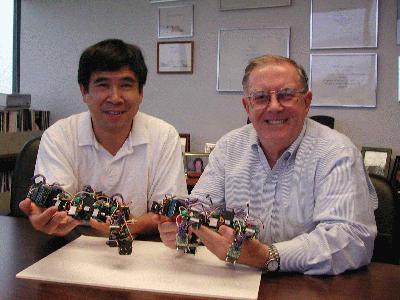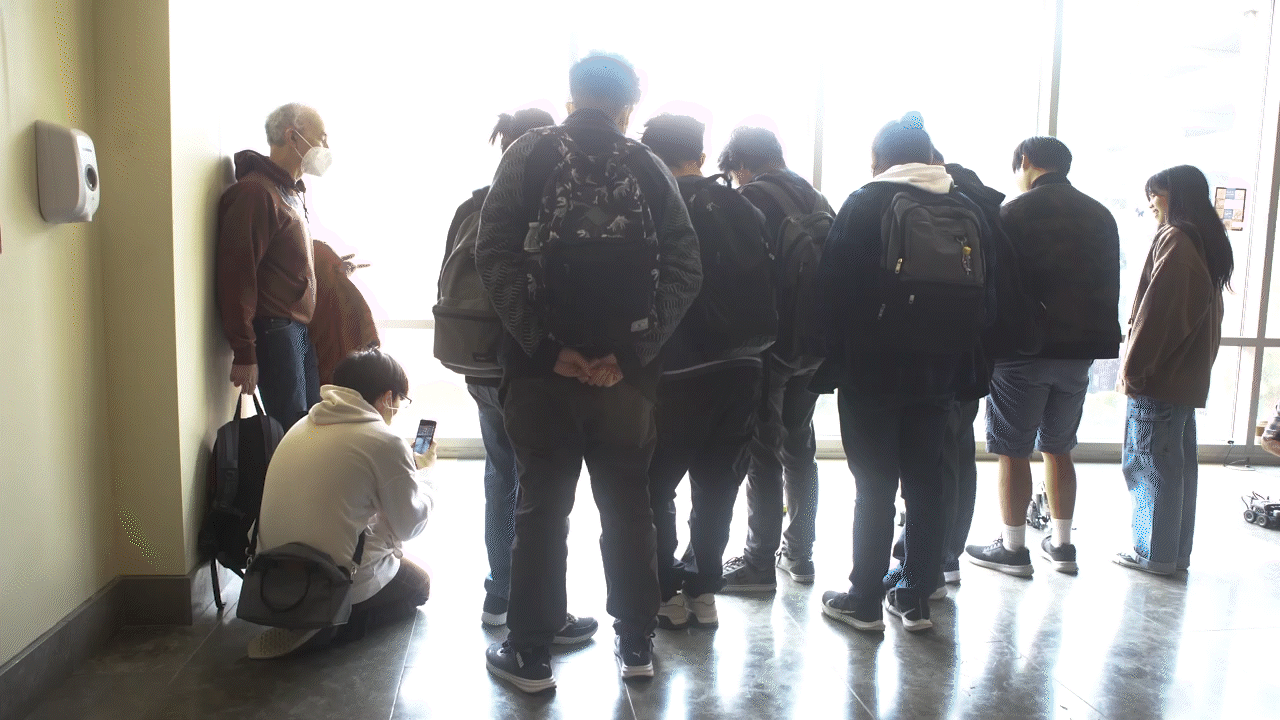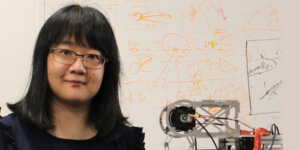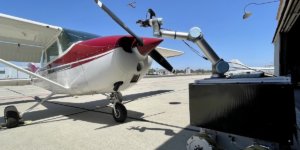
Wei-Min Shen, left, and Peter Will, holding hormone software controlled CONRO modules
A generation of children grew up mesmerized by the animated exploits of Transformers — small, simple robots with the power to unite themselves to form a whole range of specialized giant ones. Now, the science of robotics is starting to catch up with Saturday morning TV.
Researchers from ISI’s Polymorphic Robotics Laboratory have created working robotic units designed to similarly knit themselves together.While these will not soon turn themselves from tanks to airplanes to submarines, the individual, identical modular units will autonomously look for and find each other, link themselves to one another and then, when united, work effectively a single unified whole.
And while they are far from ready to defend the world against invasion by evil space aliens, developed versions of the prototype ISI devices — known as CONROs, for CONfigurable RObots – may soon be trekking individually through small crevices in earthquake debris or at a fire scene.
Inside, they might link up into devices that could carry cameras, water, medicine or other help for trapped people, or even help jack up rocks and push them out of the way.
Other possible applications are for surveillance or scouting on the battlefield. Microscopic versions might even assemble inside the body to form surgical instruments.
The existing CONRO units are about three inches long, consisting of a few small electric motors, a computer chip, and an active end that can move back and forth and up and down. This end also has plugs on three sides that fit into receptacles on the front ends of other devices. An onboard computer chip on each module directs the activities of the robot.
Each unit’s chip can also receive and send instructions to the processors in its sister units using infrared transmitters like those used in TV remote controls.
Robot software expert Wei-Min Shen, who has had experience programming autonomous wheeled robots to play soccer in the annual “RoboCup,” has pioneered the development of software modules for CONRO called “hormones” by analogy with biological chemical messengers which do much the same.
Shen believes that by orchestrating such software hormones it will be possible to program any needed movement
More than a year ago, the working group recently succeeded in the seemingly modest step of having a snake of six robots find and link to its own tail to form a ring.
In another configuration, with six units linked as legs to a seventh and eighth units which serve as a body, an insect-like creature emerges which can walk on six legs, moving three at a time.
A recent development is a snake that reconstructs itself into a capital T-shaped assembly that “flies” or “swims” by moving the sides of the T crossbar like wings or fins
Peter Will, who in 1990 received the robotics profession’s highest honor, the International Engelberger Prize, directs the CONRO project. He notes that creation of truly capable Transformer (he prefers the word “metamorphing”) robots will require improvements in many areas, including the development of chips that do more with less power.
ISI’s Polymorphic Robots Laboratory is not the only site of research on modular, self-assembling robots. Xerox Parc has long been working on a parallel project, called PolyBots.
CONRO’s reconfiguration behaviors are also autonomous and controlled in a totally distributed mannor, Shen says, which distinguishes CONRO from many existing chain-typed self-reconfigurable robots, such as those from Xerox Parc.
The demands on software to achieve this performance are daunting. “The robots must recognize the conditions that dictate a change in form, must determine the proper new form to assume, and be able to do so quickly and efficiently under confused, real world conditions.” he said. “These are major challenges. Nevertheless, the rewards for successful implementation of this technology make a vigorous effort worthwhile, and we are cheered by the successes we have so far achieved.”
The CONRO research is supported by DARPA. The software research receives funding from the Air Force Office of Scientific Research.
Published on April 12th, 2001
Last updated on August 10th, 2021











